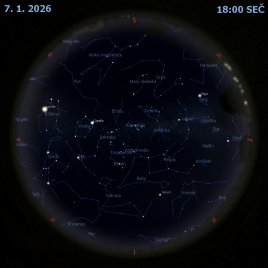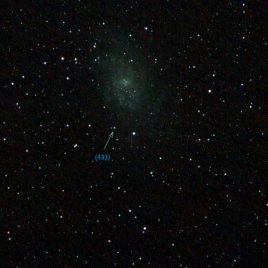Dlouhé ohony komety Tsuchinshan-ATLAS

Uznání a copyright: Jose Santivañez Mueras
Na večerní oblohu se blíží jasná kometa.
Kometa
C/2023 A3 (Tsuchinshan-ATLAS)
se zjasnila, a přestože je nyní snadno
viditelná
pouhým okem, je tak blízko Slunce, že je stále obtížně pozorovatelná.
Kometa
Tsuchinshan-ATLAS
na
snímku
byla zachycena těsně před východem Slunce z
pohoří And
v
Peru.
Toto neobvykle
vysoké místo pozorování
i přes chladné počasí astrofotografovi poskytlo tak nízký východní obzor, že
kometa
byla na obloze před svítáním zřetelná.
Na
snímku
je patrný nejen
působivě dlouhý
prachový ohon táhnoucí se přes
mnoho stupňů,
ale také pozoruhodně dlouhý modrý
iontový ohon.
Jak se tento měsíc
kometa už vzdaluje
od
Slunce
a míjí
Zemi,
tak by měli pozorovatelé večer spatřit tu obrovskou špinavou
ledovou kouli
na západě těsně po
západu Slunce.
Poznámka překladatele: Výslovnost názvu komety je cu-ťin-šan-atlas, viz stránku Antonína Vítka Transkripce čínštiny.
Seznam odkazů v popisu
- Wikipedia: 2023_A3_(Tsuchinshan–ATLAS)
- TheSkyLive.com: Comet C/2023 A3 (Tsuchinshan-ATLAS)
- APOD: 2024-09-30 Kometa Tsuchinshan ATLAS nad Mexikem
- Flickr.com: José Santivañez Mueras: Tsuchinshan-Atlas-02-10-2024desde Huaytapallana-Huancayo
- Youtu.be: ANDES- A 4K Aerial Film of Peru
- Wikipedia: Peru
- APOD: 2011-04-17 Pohled z Everestu
- NASA: Comets
- Flickr.com: José Santivañez Mueras: Tsuchinshan-Atlas-02-10-2024desde Huaytapallana-Huancayo
- BoredPanda.com: Foto: Kočka hlavou dolů mezi polštáři :-)
- GeoGebra.org: Degrees and Radians
- APOD: 2024-03-26 Iontový ohon komety Pons Brooks
- Facebook: Simulation: The Future of Comet A3 as Seen from the Earth Nico Lefaudeux
- NASA: All about the Sun!
- APOD: 2022-02-06 Modrá skleněná kulička Země
- APOD: 2015-11-18 Náhlý výtrysk na kometě 67P
- NASA: Malebný západ slunce při rovnodennosti
NASA Official: Phillip Newman Specific rights apply. NASA Web Privacy Policy and Important Notices
A service of: ASD at NASA / GSFC & Michigan Tech. U.
Odkaz na originální APOD


